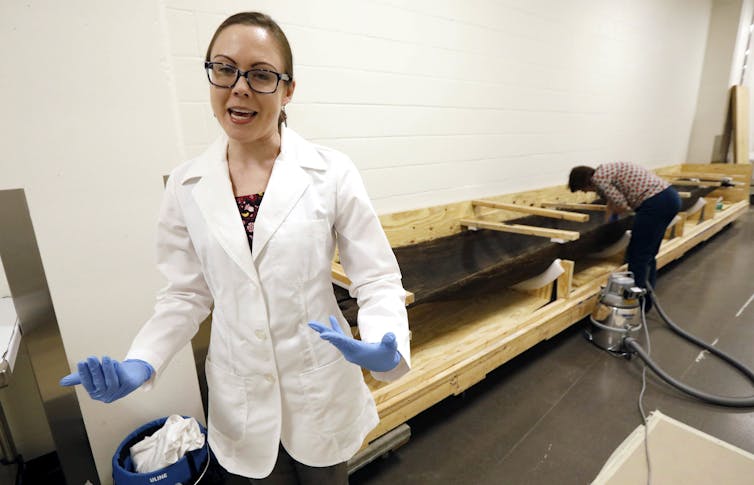Throughout history, Indigenous peoples have been responsible for the development of many technologies and have substantially contributed to science.
Science is the pursuit of knowledge. Approaches to gathering that knowledge are culturally relative. Indigenous science incorporates traditional knowledge and Indigenous perspectives, while non-Indigenous scientific approaches are commonly recognized as Western science. Together, they contribute substantially to modern science.
Although the value of integrating Indigenous science with Western science has been recognized, we have only begun to scratch the surface of its benefits.
Indigenous perspectives are holistic and founded upon interconnectedness, reciprocity and the utmost respect for nature. Both Western and Indigenous science approaches and perspectives have their strengths and can greatly complement one another.
As an Indigenous scientist who specializes in combining traditional ecological knowledge with wildlife ecology research, I have come across many examples where blending both approaches has resulted in excellent contributions to modern science.
Roots of food and medicine
For centuries, Indigenous people’s lives depended on their knowledge about the environment. Many plant species — including three-fifths of the crops now in cultivation and enjoyed across the globe — were domesticated by Indigenous peoples in North, Central and South America. Corn, squash, beans, potatoes and peppers are just a few examples of foods that now contribute vastly to global cuisine!

Indigenous knowledge about the medicinal properties of plants has been instrumental in pharmacological development. For example, as settlers arrived in North America, Indigenous people helped newcomers cure life-threatening scurvy through conifer-needle tonics that were rich in vitamin C.
The active ingredient in the pain reliever Aspirin, acetylsalicylic acid, was first discovered by Indigenous people who utilized the bark of the willow tree. Medicinal plant properties are still being recognized to this day — especially in tropical ecosystems — as Indigenous people share their knowledge.
Technology to TEK
Technological innovations such as the canoe, kayak, toboggan or snowshoe aided in travel and transport and were quickly adapted by European settlers.
Indigenous peoples, with their decades of personal experience combined with that of their ancestors, harbour vast knowledge about the environment and the ecological relationships within them. Tremendous opportunities exist where such knowledge can contribute to modern science and natural resource management.
Indigenous knowledge, also known as Traditional Ecological Knowledge (TEK), is essentially the cumulative body of knowledge associated with ecological relationships, which is handed down through generations by Indigenous people.
TEK has already provided insight into environmental change, wildlife population monitoring, sustainable harvesting practices, behavioural ecology, ecological relationships and so much more.

Inuit observations have identified several important environmental changes in the Arctic as a result of climate change, and their knowledge about bowhead whale behaviour helped researchers revise their survey methods to improve population size estimates.
Elders of the Heiltsuk First Nation in B.C. recognized two types of wolves — coastal and inland — previously undocumented by Western scientific methods. With such proven value in only a few examples, imagine how TEK can further inform science!
TEK continues to complement Western science. In light of recent moose population decline across North America, my own research aims to incorporate Indigenous knowledge to help identify factors that may be responsible for this decline.
Indigenous education is essential
Despite the recognized value of Indigenous perspectives and knowledge, there are few Indigenous science scholars. Scholars with specialization in Indigenous science can provide mentorship as well as become role models for current and prospective Indigenous science students.
By encouraging Indigenous science scholar recruitment, forthcoming research incorporating Indigenous perspectives can pave the way to promote culturally inclusive scientific approaches.
Many wildlife species are at risk across the planet, and engaging in co-operative management initiatives that embrace Indigenous science are now more important than ever. Collaborations are becoming more and more common. For example, the Canadian government incorporates TEK in assessing species at risk. The Worldwide Indigenous Science Network (WISN) restores TEK dialogue to the world’s most pressing ecological issues.
Throughout history, Indigenous people, perspectives, and knowledge have contributed substantially to the development of science and technology and will surely continue to do so for generations to come!
Further reading
Indian Givers: How Native Americans Transformed the World by Jack Weatherford. Broadway Books, 2010.
Indigenous Knowledge, Ecology, and Evolutionary Biology by Raymond Pierotti. Routledge, 2011.
“What tradition teaches: Indigenous knowledge complements western wildlife science” by Paige M. Schmidt and Heather K. Stricker. USDA National Wildlife Research Center – Staff Publications, 2010.

